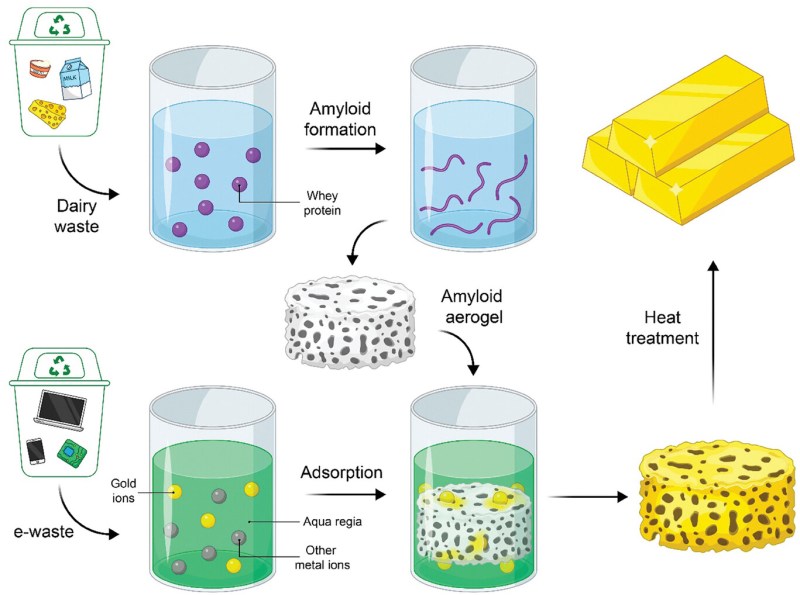A big part of the recycling of electronic equipment is the recovery of metals such as gold. Usually the printed circuit boards and other components are shredded, sorted, and then separated. But efficiently filtering out specific metals remains tricky and adds to the cost of recycling. A possible way to optimize the recovery of precious metals like gold could be through the use of aerogels composed out of protein amyloids to which one type of metal would preferentially adsorb. According to a recent research article in Advanced Materials by [Mohammad Peydayesh] and colleagues, such aerogels could be created from protein waste from the food industry.
The adsorption mechanism of the protein amyloids is a feature of these proteins which form chelants, which are structures that can effectively bond to metal ions. These are usually organic compounds, and are used in certain medical treatments where heavy metal poisoning is involved (chelation therapy). By having these protein amyloids in an aerogel structure, the surface area for adsorption is maximized, which in the research article is said to have an efficiency of 93.3% for gold recovery, while leaving the other metals in the aqua regia solution (nitric and hydrochloric acid) mostly untouched.
Of note here is that although the food waste protein angle is taken, the experiment used whey protein. This is also one of the most popular food supplements in the world, to the point that microbial production of whey is a thing now. Although this doesn’t invalidate the aerogel chelation approach to e-waste recycling, it’s a curious omission in the article that does not appear to be addressed.

















see also “WHEY – The waste-stream that became more valuable than the food product”
https://doi.org/10.1016/j.tifs.2021.08.025
Can they then send the now gold free solution to a 2nd, 3rd and even 4th aerogel to extract different things like Paltinum etc?
Amazing how people ignore human factors, especially in incentivization. Thy fact that you’re calling out the food waste stream means people like you have incentivized the use of said term and are surprised when people use it without proof. However, it should also be obvious that when attempting to prove a concept, one might start with pure ingredients to prove the concept, and once its show to work, see how impure ingredients, like from a waste stream, might impact the process.
Unfortunately the article above actually further makes the point that whey is no longer a waste stream.
The key sentence from the article: “Given the volume, composition and organic load, sweet whey used to be regarded as a waste-stream which was treated as cheaply as possible (e.g. as animal feed) due to restrictions on the disposal of untreated whey. However, the technological development of the dairy industry together with research have converted sweet whey to a valuable raw material with the same value as cheese (if not above).”
Interesting reading. https://onlinelibrary.wiley.com/doi/full/10.1002/adma.202310642
Whey to go, material scientists!
Very nice but it requires the gold be in an aqua regia solution.
Yeah, but I suppose it’s better than using mercury for the task as it usually is…
The article is just green washing a nonetheless environmentally hazardous process. I wouldn’t be surprised if food waste was mentioned only to secure some government grant when in practice no food waste would be utilized, e.g. whey is no longer food waste.
This very important bio chemical process will be illuminated in the next season of Rick and Morty and it will be Gerry who stumbles across it during Rick’s “ spaghetti night dinner.
Read the original article and just shook my head.. I process e-wast and all they seemed to do was add an extra step. If your using aqua Rega (nitric & hydrochloric acid) to remove the gold all u need is sodium metabysolphate to drop it out. From what I could tell you wind up needing more acid not less.